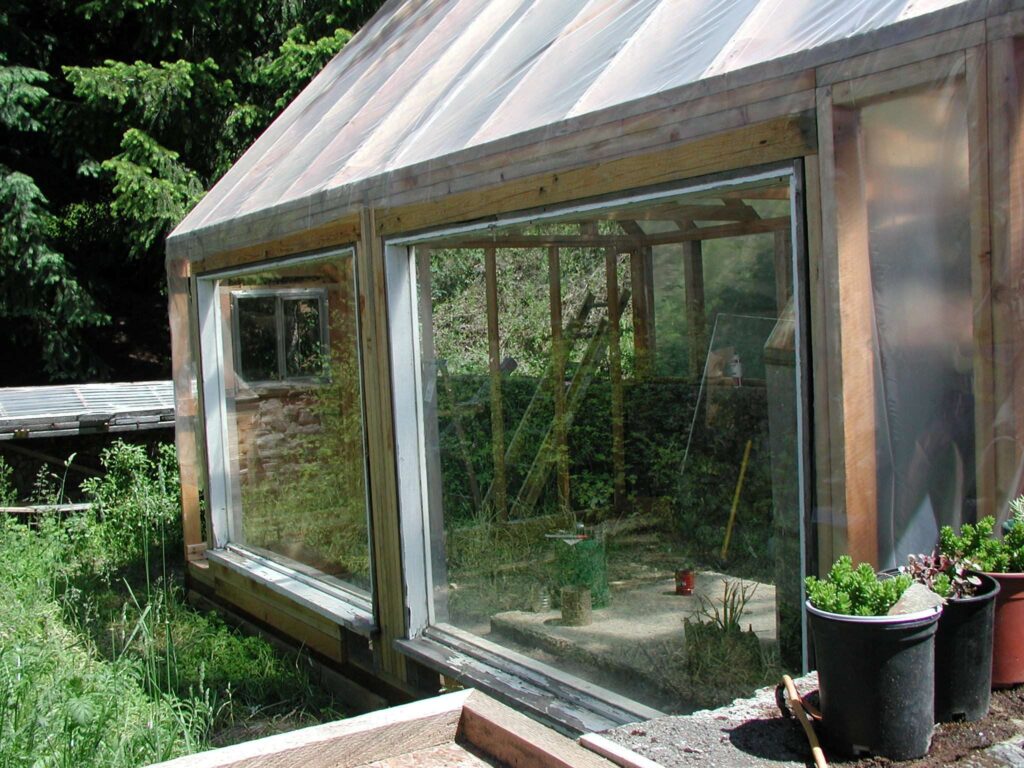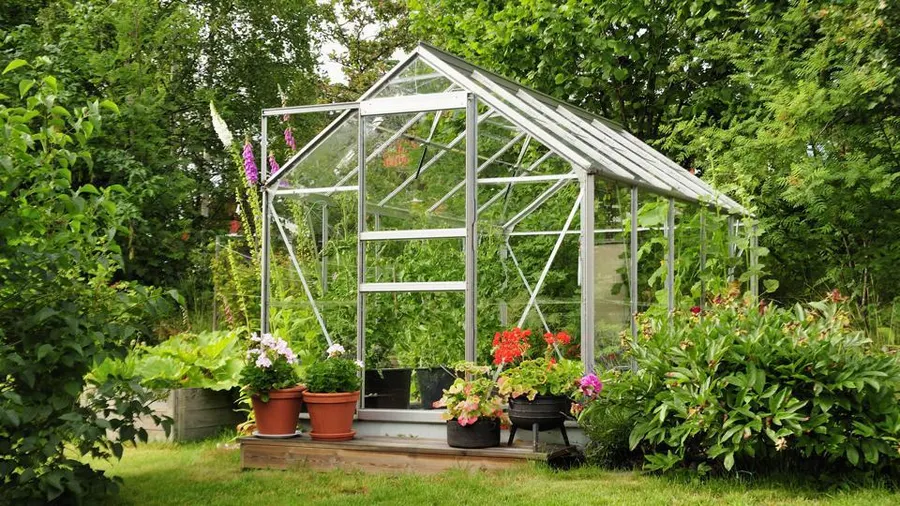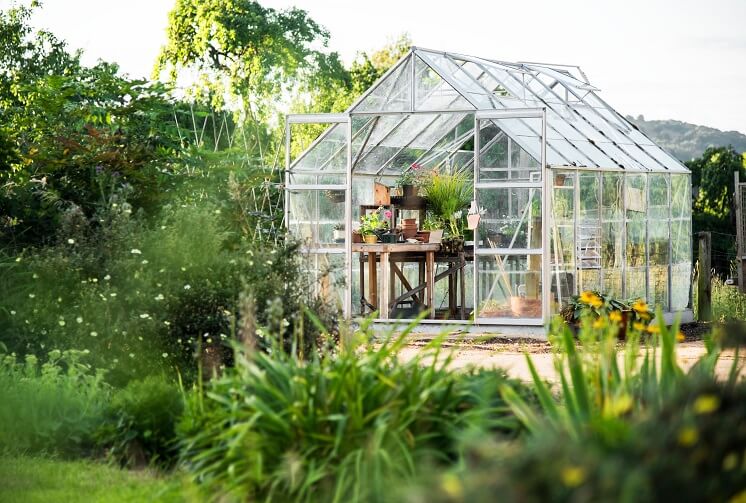Double-pane windows offer several advantages when used in greenhouses. They provide superior insulation by trapping a layer of air or gas between the panes, stabilizing temperatures inside and minimizing heat loss or gain. This improved insulation contributes to greater energy efficiency, reducing the need for constant heating or cooling and potentially lowering energy costs.
Moreover, double-pane windows help control condensation, preventing issues like mold and water damage to plants. Some versions also come with UV protection, shielding delicate plants from harmful rays.
While they offer sound insulation as well, it’s not a primary concern for greenhouse use. When selecting double-pane windows, consider local climate, plant needs, and proper installation to optimize their effectiveness in maintaining an ideal greenhouse environment.
How are Double Pane Windows Constructed?

Double pane windows are crafted with precision engineering techniques to create a barrier against heat transfer, optimize light transmission, and control condensation.
Definition and Construction of Double Pane Windows
Double pane windows, also known as double-glazed windows, are composed of two glass panes separated by a space filled with an insulating gas and sealed together. These windows are designed to provide enhanced insulation compared to traditional single-pane windows commonly used in buildings and structures.
The construction of double pane windows involves precision engineering to ensure optimal performance. The two glass panes, typically made of tempered or annealed glass, are spaced apart by a specific distance, creating a gap that ranges from a fraction of an inch to several millimeters. This space between the panes is crucial, as it determines the insulating properties of the window.
Components of Double Pane Windows
These are the primary components of double pane windows. The glass panes are manufactured to meet specific standards, ensuring durability and transparency while allowing light to pass through.
The gap between the glass panes is filled with an insulating gas, such as argon or krypton. These inert gasses have higher insulating properties than air, reducing heat transfer between the interior and exterior of the window. The gas is inserted into the space during manufacturing, contributing to the window’s overall thermal efficiency.
To maintain the integrity of the insulating gas layer and prevent moisture infiltration, the perimeter of the two glass panes is sealed. This sealing process is critical in ensuring that the gas remains trapped between the panes, maximizing the window’s insulation capabilities.
Functionality of Double Pane Windows
The primary function of double pane windows is to provide superior insulation compared to single-pane windows. The insulating gas layer between the glass panes acts as a barrier, significantly reducing heat transfer. This results in better temperature regulation within the greenhouse, keeping it warmer in cold weather and cooler in hot weather.
Double pane windows are engineered to allow optimal transmission of natural light while minimizing the negative effects of harsh UV rays. The design of these windows ensures that plants receive adequate sunlight for photosynthesis without causing overheating or damage to sensitive plant tissues.
The insulating properties of double pane windows also help control condensation. By maintaining more consistent temperatures on both sides of the window, these windows reduce the likelihood of moisture buildup, which can lead to visibility issues and create an environment conducive to mold and fungal growth.
What Benefits Do Double Pane Windows Offer in Greenhouses?
The benefits of double pane windows in greenhouses extend beyond insulation and include optimized light transmission, condensation control, humidity regulation, and enhanced durability.
Enhanced Insulation for Temperature Regulation
Reduced Heat Loss
Double pane windows significantly minimize heat loss from the greenhouse during colder seasons. The insulating gas layer and sealed design create a barrier that impedes the transfer of heat between the interior and exterior environments, helping maintain higher temperatures inside the greenhouse.
Temperature Stability
By reducing heat loss, these windows contribute to a more stable internal temperature. This stability is crucial for protecting plants from temperature fluctuations, creating a more conducive environment for consistent growth throughout the year.
Energy Efficiency
Enhanced insulation provided by double pane windows leads to reduced reliance on heating systems, thereby lowering energy consumption. This translates into cost savings for greenhouse operators while decreasing the environmental impact associated with excessive energy usage.
Optimized Light Transmission for Plant Growth
Controlled Sunlight Exposure
Double pane windows are designed to allow a controlled amount of sunlight into the greenhouse. They minimize the negative effects of excessive UV rays that can damage plants while ensuring an adequate level of natural light reaches the plants for photosynthesis.
Balanced Light Diffusion
These windows distribute natural light evenly across the greenhouse, optimizing the growth conditions for plants throughout the space. By reducing glare and shadows, double pane windows create a more uniform light environment, promoting healthier plant development.
UV Protection
The construction of double pane windows includes coatings or treatments that filter harmful UV rays. This protection helps prevent sunburn or damage to plants, ensuring their sustained growth and productivity.
Condensation Control and Humidity Regulation
Minimized Condensation
Double pane windows aid in controlling condensation by maintaining more consistent temperatures on both sides of the glass. This reduces the formation of condensation on the window surface, preventing moisture-related issues such as reduced visibility and potential damage to plants.
Improved Humidity Management
The ability of these windows to control condensation also contributes to better humidity regulation within the greenhouse. Consistent humidity levels are essential for plant health, and double pane windows help create an environment conducive to optimal growth conditions.
Durability and Longevity in Greenhouse Environments:
Resistance to Environmental Elements
Double pane windows are constructed using durable materials that withstand the harsh conditions often present in greenhouse environments, such as temperature variations, high humidity, and exposure to moisture and chemicals used in farming practices.
Longevity and Reduced Maintenance
Their robust construction minimizes the need for frequent replacements or repairs. This durability leads to cost savings over time and reduces the environmental impact associated with the disposal of worn-out materials.
How Do double-pane windows Improve Energy Efficiency in Greenhouses?

Double pane windows play a pivotal role in improving energy efficiency, reducing the environmental impact, and providing long-term cost savings for greenhouse operators.
Role of Double Pane Windows in Reducing Energy Consumption
Double pane windows are instrumental in reducing the energy required for heating and cooling within greenhouses. Their superior insulation properties minimize heat transfer, resulting in less reliance on artificial heating systems during colder periods and reduced need for excessive cooling in warmer climates.
By maintaining more stable temperatures, these windows decrease the workload on heating, ventilation, and air conditioning (HVAC) systems. This leads to lower energy consumption and operational costs associated with maintaining optimal growing conditions for plants.
The energy efficiency of double pane windows aligns with sustainability goals, contributing to a greener approach to greenhouse management by decreasing the overall energy demand of the facility.
Environmental Impact and Carbon Footprint Reduction
Reduced energy consumption due to the use of double pane windows results in lower greenhouse gas emissions associated with energy production. This aligns with environmental initiatives aimed at curbing carbon emissions and mitigating climate change.
The longer lifespan and durability of double pane windows compared to single-pane alternatives reduce the need for frequent replacements. This translates to decreased raw material usage, manufacturing processes, and waste generation, contributing positively to environmental conservation efforts.
Incorporating double pane windows into greenhouse design represents a commitment to sustainability by adopting energy-efficient technologies. It demonstrates a proactive approach to minimizing environmental impact and promoting responsible resource management in agricultural operations.
Long-term Cost Savings and Benefits for Greenhouse Operators
Although the initial cost of installing double pane windows may be higher, the long-term benefits outweigh this investment. Reduced energy bills resulting from lower heating and cooling requirements lead to significant cost savings over the lifespan of the greenhouse.
The energy savings and decreased operational costs associated with double pane windows contribute to a favorable ROI for greenhouse operators. This financial return can positively impact the overall profitability and viability of the agricultural enterprise.
Operating a sustainable greenhouse equipped with energy-efficient features like double pane windows can enhance a business’s market position. Consumers increasingly favor environmentally conscious products, potentially leading to increased demand and market competitiveness for produce grown in eco-friendly facilities.
FAQ’s
Do greenhouses have special windows?
Yes, greenhouses often use specialized windows like double pane windows designed to provide insulation and regulate temperature.
Why do greenhouses have glass windows?
Glass windows in greenhouses facilitate light transmission while creating a controlled environment optimal for plant growth.
What materials are used for greenhouse glazing?
Greenhouse glazing materials include glass, polycarbonate, acrylic, or polyethylene films to provide transparency and insulation.
What is the best surface for a greenhouse?
The best surface for a greenhouse depends on factors like light transmission, insulation, durability; materials like glass or polycarbonate are commonly used.
Are double glazed windows eco-friendly?
Yes, double glazed windows contribute to eco-friendliness by reducing energy consumption and carbon emissions in greenhouse operations.
How thick is greenhouse glazing?
Greenhouse glazing thickness varies; for example, glass can range from 3mm to 10mm, while polycarbonate can be between 4mm to 10mm, depending on specific needs.
FInal Words
In conclusion, the adoption of double pane windows in greenhouse construction represents a significant step towards enhancing efficiency and sustainability in agricultural practices. Their ability to provide better insulation, regulate temperature and humidity, optimize light transmission, and contribute to energy efficiency makes them an ideal choice for modern greenhouse design.
As the focus on environmentally friendly practices intensifies, the utilization of double pane windows stands out as a valuable solution in creating more sustainable and productive greenhouse environments.

